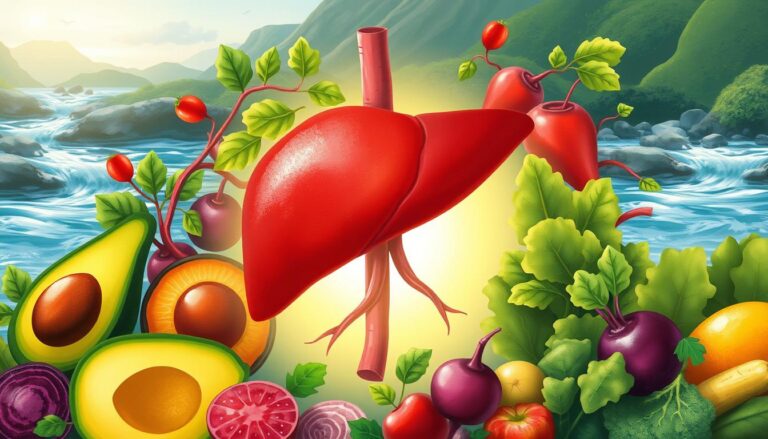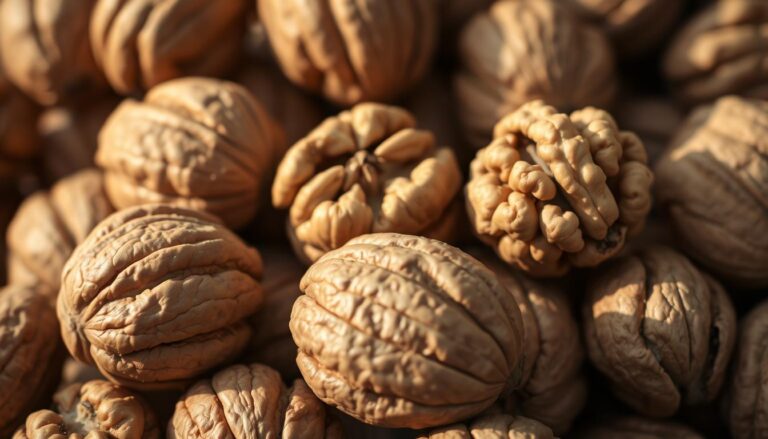Feeling sluggish or having digestive issues? Struggling with your weight? It might be because you’re not getting enough fiber. Fiber is key for many health benefits, like helping with weight control and lowering disease risk. But, only 7% of U.S. adults meet the daily fiber needs. So, how do you know if you’re not getting enough? Let’s look at the 7 signs that might surprise you.
Key Takeaways
- Fiber is vital for a healthy digestive system, managing blood sugar, and boosting overall health.
- Enough fiber intake can cut the risk of heart disease, diabetes, and some cancers.
- Most Americans don’t get the fiber they need, which is bad for their health.
- Knowing the signs of fiber lack can lead to better diet changes for better health.
- Adding more fiber-rich foods to your diet can greatly improve your health.
The Importance of Fiber
Fiber is key for good health and well-being. It comes in two main types: soluble and insoluble. Soluble fiber, found in oats, beans, and fruits, turns into a gel-like substance. This can help lower cholesterol and keep blood sugar stable. Insoluble fiber, in whole grains, nuts, and veggies, helps with regular bowel movements.
Types of Fiber and Their Benefits
Getting enough soluble and insoluble fiber is important for digestive health. Women aged 19 to 50 should eat about 25 grams of fiber daily. After 50, aim for around 21 grams. Men aged 19 to 50 need about 38 grams, decreasing to 30 grams after 50. Sadly, most people only get 10 to 15 grams of fiber a day.
Whole fruits and veggies are top fiber sources. Soluble fiber forms a gel in the gut, helping prevent cholesterol and fat absorption. Insoluble fiber makes stool bulkier and softer, aiding bowel movements.
Eating more fiber from plants can help control blood sugar, make you feel full, and prevent hunger. Fiber-rich foods are better for health than supplements. It’s key to slowly add more fiber to your diet to avoid issues like gas and bloating.

Talking to a dietitian can help check your fiber levels and add more fiber-rich foods to your diet. This might mean switching to whole grains, eating more fruits, veggies, seeds, nuts, beans, and legumes.
You’re Constipated
One of the most obvious signs that you’re not getting enough fiber is chronic constipation. Fiber makes your stool bulkier and helps with smooth bowel movements. Insoluble fiber acts like a “scrub brush” in your digestive tract. It keeps things moving and stops food from sticking, which can cause constipation. Eating more fiber-rich foods like fruits, veggies, and whole grains can help.
Studies show that most American adults only get 15 grams of fiber a day, which is less than needed. Men need 30 to 40 grams of fiber daily, based on their size and activity level. Women should aim for about 25 grams. Not getting enough fiber can lead to constipation. Fiber softens stools by absorbing water, making them easier to pass through your intestines.
- Insoluble fiber acts as a “scrub brush” in the digestive tract, keeping things moving and preventing constipation.
- Increasing your intake of fiber-rich foods like fruits, vegetables, and whole grains can help alleviate constipation.
- The recommended fiber intake is 14 grams per 1,000 calories consumed, but the average American falls short at only 15 grams per day.
By adding more fiber to your diet, you can keep your digestive system running smoothly. This helps prevent the discomfort of chronic constipation.
You Experience Diarrhea or Loose Stools
Eating more fiber can help with bowel movements and fight constipation. But, it’s key to find the right balance. Too much fiber without enough water can cause diarrhea or loose stools.
Soluble fiber absorbs water in the gut, making stools firmer. Yet, it’s important to balance fiber with water to avoid constipation or diarrhea.
95% of U.S. adults don’t get enough fiber. Women need 25 grams of fiber daily, while men aged 19-50 need 38 grams. Eating more fiber-rich foods and drinking enough water helps keep bowel movements regular and prevents diarrhea.
“Including fiber in the diet regularly helps with stool frequency, and lack of fiber in the diet can lead to occasional diarrhea.”
There are two kinds of fiber: soluble and insoluble. Soluble fiber, found in oats, beans, and avocados, absorbs water and makes stools firmer. Insoluble fiber, in whole grains and veggies, adds bulk and slows down digestion.
By balancing these fibers and staying hydrated, you can manage your digestion well. This helps avoid constipation or excess fiber and diarrhea.
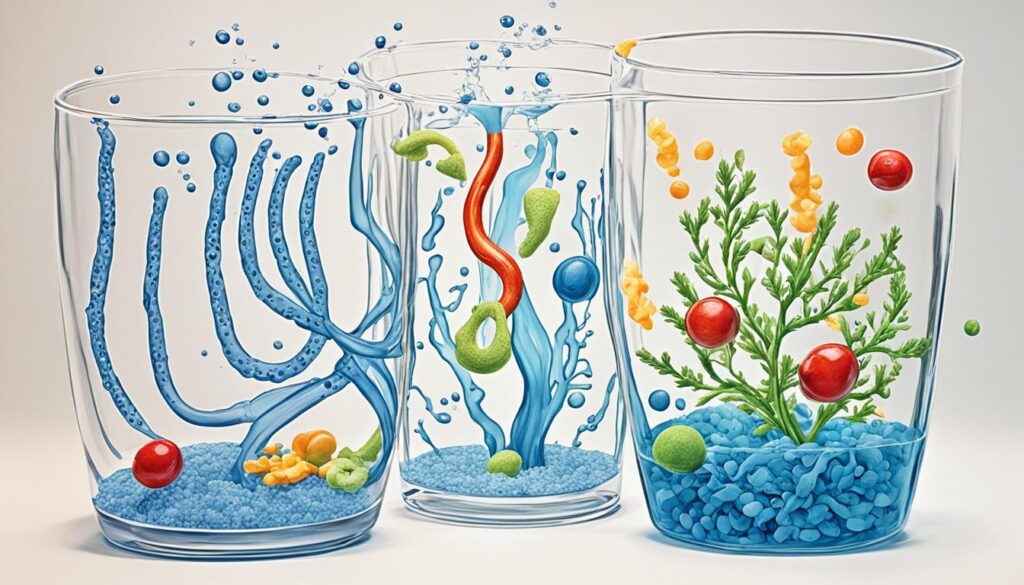
7 Signs You’re Not Eating Enough Fiber
Most people know fiber is good for digestion. But, not getting enough fiber can cause many health problems. These include feeling tired, gaining weight, and having high cholesterol. If you notice these signs, you might need to eat more fiber.
- Frequent constipation or diarrhea. Fiber keeps bowel movements regular. If you often have digestive issues, you might not have enough fiber.
- Persistent hunger and low energy. Fiber makes you feel full for longer. If you’re always hungry, you might not be getting enough.
- Elevated LDL cholesterol. Soluble fiber lowers “bad” LDL cholesterol. High levels could mean you’re not getting enough fiber.
- Unexplained weight gain. Fiber helps you feel full and control blood sugar. Not having enough might lead to weight gain.
- Frequent bloating and gas. Fiber helps with digestion and keeps the gut healthy. Ongoing discomfort could mean you’re not getting enough fiber.
- Vitamin and mineral deficiencies. Fiber helps absorb important nutrients. Not getting enough can lead to anemia or weak bones.
- Lack of mental clarity and focus. Fiber affects blood sugar and gut health, which can impact your brain and energy.
The daily fiber intake should be at least 25 grams. But, Americans only get about 14 grams a day. Eating more whole grains, fruits, vegetables, and legumes can help. This can fix fiber-related health issues and improve overall health.

“Eating 10 additional grams of fiber per day can decrease the risk of early death by 10%.”
You Can’t Seem to Satisfy Your Hunger
Do you often feel hungry even after eating? This could mean your diet lacks fiber. Foods high in fiber make you feel full longer because they digest slowly. They also expand in your stomach, making you feel more satisfied.
If you’re always looking for snacks after meals, it’s time to check your fiber levels. Adding more whole grains, fruits, veggies, and legumes to your diet can help. These foods keep you full and support weight management.
Experts say you should aim for 25-30 grams of fiber daily. But many Americans only get about 15 grams. This can lead to constant hunger and overeating.
“Fiber is a key player in keeping you feeling satisfied and curbing hunger. When you don’t get enough, it can disrupt your body’s natural satiety signals, leading to constant cravings and overeating.”
Don’t let fiber deficiency ruin your efforts to control your hunger and weight. Focus on eating more high-fiber foods. You’ll notice your cravings and hunger decrease. Your body and mind will appreciate the steady energy boost from fiber.
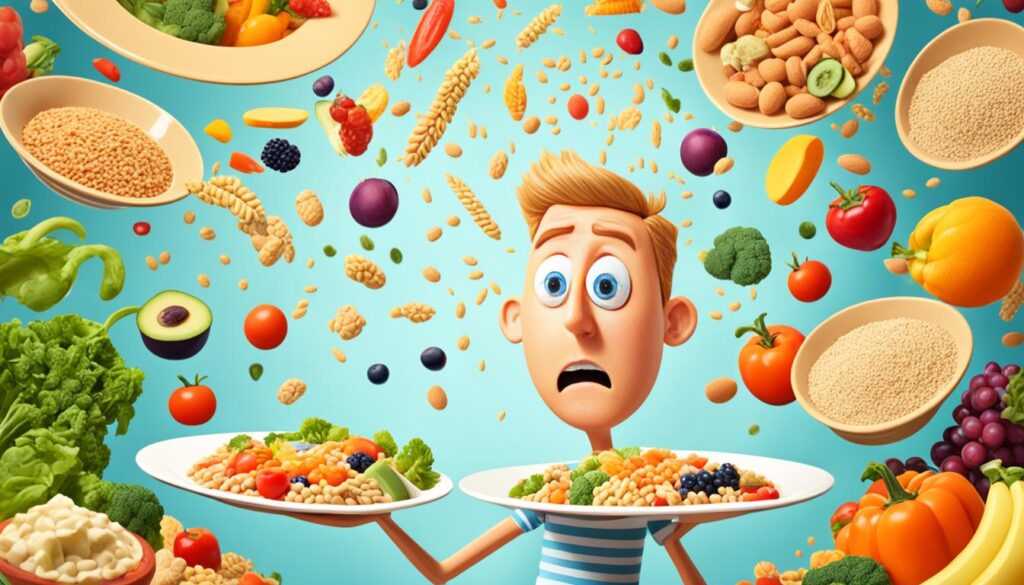
Your LDL-Cholesterol is High
If your LDL (the “bad”) cholesterol levels are high, it might mean you’re not eating enough fiber. Soluble fiber can help lower LDL cholesterol by reducing how much cholesterol your body absorbs. It also helps move cholesterol out of your body before it can block arteries. Eating 7 grams of fiber daily can lower your heart disease risk by 9 percent.
The American Heart Association has guidelines for LDL cholesterol levels. They range from Optimal (less than 100 mg/dL) to very high (190 mg/dL and above). If you have heart disease or diabetes, your doctor might want your LDL to be even lower, around 70 mg/dL.
To lower your LDL cholesterol, eat more fiber-rich foods. Try oats, barley, beans, and psyllium. These foods are full of soluble fiber. They can make you feel full longer, help with weight control, and lower heart disease risk.
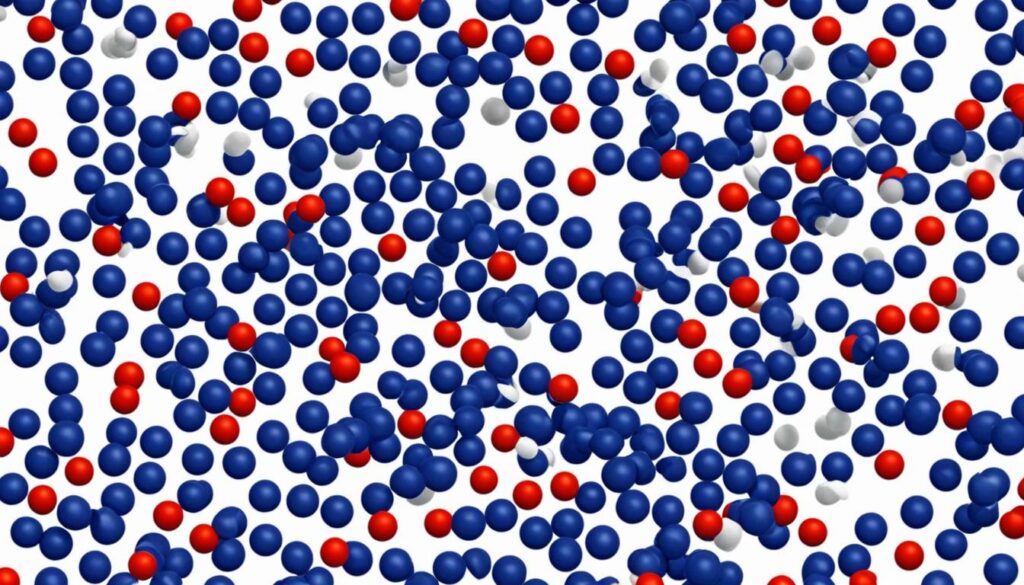
“Consuming more soluble fiber can be a simple and effective way to help lower LDL cholesterol levels and reduce your risk of heart disease.”
You Feel Sluggish
Fiber and Energy Levels
Feeling tired all day might be because you’re not getting enough fiber. Foods high in fiber give you energy slowly, keeping your blood sugar stable. Without enough fiber, you might feel very tired after eating, as your body quickly uses the sugar from food.
A 2021 study found that only 7% of Americans get enough fiber. Men need 38 grams and women need 25 grams daily. But most people only get about 14 grams. Eating foods rich in fiber can stop your blood sugar from going up and down, giving you steady energy all day.
Foods like chia seeds, strawberries, oats, quinoa, chickpeas, lentils, broccoli, and bananas can give you steady energy and make you feel less tired.
| Fiber Intake Recommendations | Grams per Day |
|---|---|
| Children below 18 years | 14-31 grams |
| Men below 50 years | 31-34 grams |
| Women below 50 years | 25-28 grams |
| Men above 50 years | 28 grams |
| Women above 50 years | 22 grams |
“Soluble fiber helps in managing and balancing blood sugar levels, preventing rapid spikes and drops that lead to energy dips and exhaustion.”
Eating more foods high in fiber can give you more energy and help you feel less tired.
You’re Gaining Weight and Don’t Know Why
If you’re watching your calories and exercising but still gaining weight, consider your fiber intake. Fiber is key for managing weight. Studies link low fiber to being overweight or obese.
Foods high in fiber like fruits, veggies, beans, and whole grains are usually lower in calories. They also make you feel full, helping you avoid overeating. Some research suggests fiber can even stop some calories from being absorbed, aiding in weight control.
If you’re gaining weight without explanation, check your fiber levels. Aim for 25-30 grams of fiber daily from whole foods. Adding fiber-rich foods to your meals can help you lose weight and boost your health.
| Fiber and Weight Gain | Fiber and Appetite | Fiber and Calorie Absorption |
|---|---|---|
| Fiber-rich foods are lower in calories, helping to prevent weight gain. | Fiber promotes feelings of fullness, reducing the likelihood of overeating. | Some fibers can bind to calories and prevent them from being fully absorbed by the body. |
For lasting weight control, mix a fiber-rich diet with regular exercise. Don’t let fiber shortages ruin your health goals.
You’re Bloated
If you often feel bloated and uncomfortable, it might mean you’re not eating enough fiber. Fiber, especially prebiotic fiber, feeds the good bacteria in your gut. Without enough fiber, your gut health can suffer, causing more gas and discomfort.
Studies show that up to 20% of people in the U.S. deal with bloating often, often because they don’t get enough fiber. The daily fiber need is 25 grams for women and 38 grams for men, but most get only 16 grams. Eating more fiber-rich foods can help your gut microbiome and ease digestive issues.
But, don’t suddenly increase your fiber intake. Doing so can cause more gas, constipation, diarrhea, and bloating. The goal is to add fiber and prebiotics to your diet slowly to support better gut health and digestion.
- Focus on soluble, prebiotic fibers in fruits, vegetables, whole grains, and legumes.
- Drink plenty of water to help fiber move through your digestive system smoothly.
- Limit foods and habits that can cause bloating, like carbonated drinks and chewing gum too much.
By making fiber a key part of your diet, you can ease bloating and support your digestive health. It might take time to find the right fiber balance, but the benefits are worth it.
You’re Deficient in Certain Vitamins
A diet low in fiber may mean you’re not getting enough vitamins and minerals from fruits, veggies, and whole grains. Foods high in fiber are also packed with important nutrients. For example, sweet potatoes and carrots give you vitamin A, while oats and spinach provide magnesium. If your diet is not diverse and lacks these fiber-rich, nutrient-dense foods, you could be at risk for vitamin and mineral shortages.
Research shows that people who are active often don’t get enough vitamins like B Vitamins and Vitamin D. This can affect how well they perform, recover, and feel overall. Athletes and those who exercise a lot need to make sure they get enough vitamins and nutrients. Not getting enough can mess with your metabolism and make it hard to lose weight or gain muscle.
Vitamin D is key for insulin sensitivity, fat metabolism, and calcium absorption. If you’re low on vitamins C and D, your immune system might be weaker, making you more likely to get sick. Also, low levels of certain vitamins like B6, B12, and D can cause mood swings and increase the chance of depression.
“Maintaining a diverse, fiber-rich diet is crucial for ensuring you obtain the necessary vitamins and minerals your body needs to thrive.”
By eating a mix of fiber-rich foods and vitamins, you can make sure you’re getting what your body needs for good health. A varied and balanced diet is key for getting all the nutrients you need and staying well.
Conclusion
Adding more fiber to your diet is a great way to improve your health. If you often feel constipated, bloated, or gain weight without trying, you might need more fiber. Eating more fiber-rich foods can help.
Eating enough fiber can lower the risk of heart disease and type 2 diabetes. It also helps with digestion and managing weight. Increasing fiber can make you feel more energetic and support your gut health.
Start by adding fruits, vegetables, whole grains, and legumes to your meals and snacks. This way, you can easily get the daily fiber you need. Starting a fiber-rich diet can greatly benefit your health and energy levels. So, begin your journey to better health today!


